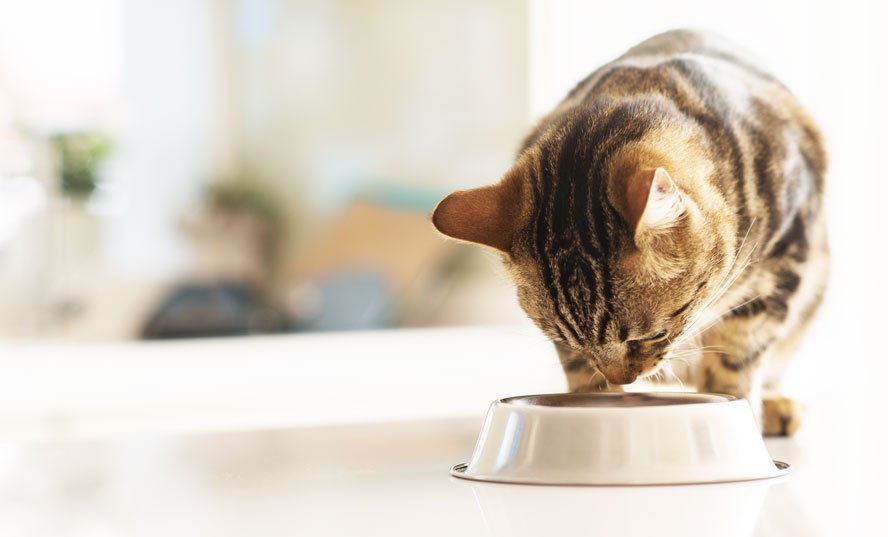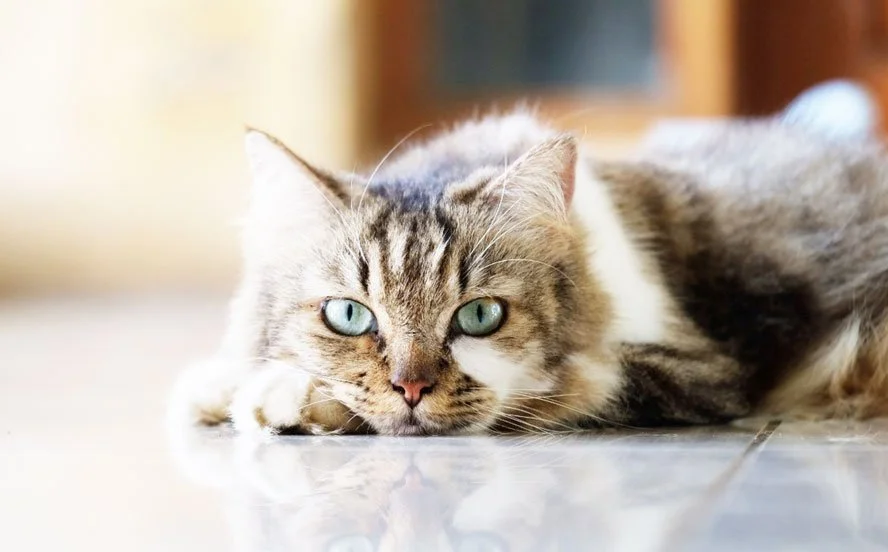cover: Lightspruch | Shutterstock
Vomiting and diarrhoea in cats. Vomiting and diarrhoea can be very unpleasant for our pets, but also for our interior. In this article you will learn how you can help your cat with gastrointestinal problems and when a visit to the vet is necessary.
What is behind diarrhoea and vomiting?
Diarrhoea and vomiting are always referred to as a symptom and not an illness. There are many different causes that can trigger both. However, they usually have one thing in common: they irritate the gastrointestinal tract and cause inflammation. As a result, the body reacts with vomiting and diarrhoea. By vomiting, it tries to relieve the stomach so that the mucous membrane can calm down. Diarrhoea occurs when the food mush is either excreted more quickly and does not have time to absorb the fluid, or there is more fluid in the faeces than usual.
What causes diarrhoea and vomiting?
There are many causes and they are rarely obvious at first glance. Therefore, close observation of your cat is important. Does she show any other symptoms? Under what circumstances do they occur? Faecal tests, which you can order yourself, are very helpful, because many pathogens can be detected there. If your cat is visibly unwell, it should always be examined by a vet. Other laboratory tests, such as blood tests, can also be carried out in a vet's surgery.
The most common causes of diarrhoea and vomiting:
Infections
Parasites such as roundworms, tapeworms, hookworms or giardia, viruses (e.g. parvovirus or coronavirus), bacteria (e.g. salmonella or campylobacter) or a mixture of these pathogens are common causes of gastrointestinal illness. Even indoor cats can become infected when parasites and viruses enter the home via shoes or other objects. Disease-causing bacteria, on the other hand, often hide in raw meat.
Stress
Sensitive cats can quickly become stressed by even small changes in their environment and react with diarrhoea. It is suspected that a change in the composition of the intestinal flora, among other things, is behind this. Due to the imbalance, the food cannot be digested as usual. In addition, stress-prone velvet paws are more often affected by stomach ulcers and thus vomiting.
Sudden change of food
If the food is to be changed, this should always be done slowly - especially if your four-legged friend does not usually have much variety on the menu. You should mix the new food with the old food in increasing proportions over 5-7 days and finally replace it completely. This will allow the digestive tract and the intestinal flora to get used to the new food.
Hairballs
Long-haired cats in particular swallow a lot of hair through their daily grooming. These are indigestible and can accumulate in the stomach. They irritate the mucous membrane and cause vomiting. The best remedy is malt paste, which directly dissolves the hairs in the stomach. As a prophylactic measure, you can give it three times a week and also brush your cat regularly to remove loose hairs. Cat grass, on the other hand, is not recommended, as it causes your cat to regurgitate its fur, further irritating the oesophagus. In addition, blades of grass can get stuck in your cat's nose or throat and may need to be removed endoscopically.
Unsuitable or spoiled food
With outdoor cats, it is not always clear what they come into contact with during their forays. They also like to help themselves to things that do not agree with them. And indoor cats also like to help themselves to anything edible they find, including food scraps and houseplants. Another problem is wet food, which is not eaten immediately and remains longer. Especially in summer, this can spoil quickly and then affect the stomach.
Food intolerances and allergies
Food intolerances are not uncommon and can develop even with food that your cat has been fed for a long time and has always tolerated. Often the body reacts to the proteins contained in chicken, beef, pork or fish and at the same time develops skin problems such as itching and inflammation. If an intolerance is suspected, an elimination diet should be carried out for 10 weeks to see if the faeces normalise. This involves feeding your cat only one protein and one carbohydrate source that it has never eaten before. Less commonly used foods such as horsemeat and quinoa can be used.
Obstruction of the gastrointestinal tract
Cats love hair ties, threads and small balls. If they eat these, it can lead to an intestinal obstruction. Older cats can also develop a tumour that causes the intestines to become blocked. If there is a complete blockage, your pet will not be able to eat or will vomit up everything after a short time. Lack of defecation and constant vomiting are an emergency and must be clarified immediately at a veterinary practice!
Krakenimages.com | Shutterstock
What to do in case of vomiting and diarrhoea? First aid at home
If your cat is fit despite diarrhoea or vomiting and otherwise behaves as usual, you can first take your own measures to help her. However, if your cat is groggy and refuses to eat, you should take him or her straight to a vet. Blood in faeces or vomit is also a warning sign. If you are unsure, the Diagnosis Finder from confidu can help you to assess the situation correctly.
This is how you can help your cat with diarrhoea and vomiting:
Light diet
Unlike dogs, cats should never be on a zero diet and fast. Especially overweight cats can quickly develop metabolic problems and become seriously ill. It is better to feed your cat a light diet for 2-3 days. For example, cook boneless, skinless chicken in lightly salted water and offer it with soft boiled rice and cooked carrots. Alternatively, there is diet food that has been specially developed for gastrointestinal disorders and has sufficient energy and nutrients. It is important to offer the food in many small portions throughout the day. This way the stomach is never empty for long and the mucous membrane can regenerate. Treats and other food are forbidden during this time.
Protect the mucous membrane
There are various supplementary foods that are supposed to soothe the gastrointestinal mucosa and thicken the faeces. For cats, pastes such as Enterogelan® are best, but there are also tablets (DiaTab®) to put in the mouth or powder (Stullmisan®) to mix into the food. They also contain many minerals and vitamins that the body loses in large quantities during diarrhoea and vomiting.
Have faeces examined
Parasites are the most common cause of infectious diarrhoea, but pathogenic bacteria are also often involved. A faecal test for worms and more gives a quick answer. The faecal sample is easily collected and quickly sent and you will receive the result within a few days. Then your cat can be helped in a targeted way.
Build up the intestinal flora
Giving pre- and probiotics will help the intestinal flora. To find out if an imbalance is the cause of the problem, you can use the faecal test from confidu and have a faecal test done. Especially if your cat has had antibiotics for another condition, this can throw the gut flora out of balance and cause diarrhoea.
Are there home remedies for diarrhoea and vomiting?
A well-known remedy to protect the stomach and intestinal mucosa is elm bark. It is available as a powder that you boil with water to make a paste. Another option is psyllium husks. Mix 1 g with 20 ml of water and let it swell for 20 minutes. Both home remedies act as a protective film on the mucous membrane and absorb some of the stomach acid that irritates the mucous membrane. Give your cat small amounts of this two to three times a day, either pure or mixed with the gentle food.
dahlia T. Pribadi | Shutterstock
Special caution for the small and weak
Diarrhoea and vomiting can cause major fluid loss, especially in our smallest, older and chronically ill cats. Due to insufficient intake of nutrients and lack of energy, they are quickly weakened. Prompt presentation to the vet's office is important for them to be able to intervene quickly in case of serious illness.
Conclusion on diarrhoea and vomiting in cats
Vomiting and diarrhoea are very common symptoms. They are usually not serious, but you should take them seriously and keep a close eye on your cat. Feed them a light diet for the first few days and use other home remedies if necessary. To get to the bottom of the cause, faecal tests can be helpful.
The confidu magazine is written by our veterinarians according to current scientific standards. The articles do not replace a veterinary diagnosis, but are intended to provide you with initial information on many topics related to your animal. If you have specific questions about your pet, our vets will be happy to advise you via the confidu app.







